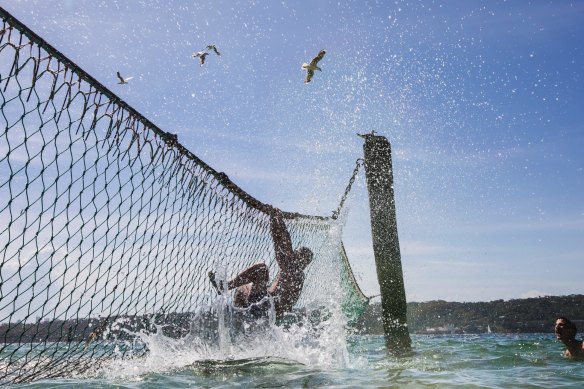This was published 2 years ago
Majority of animals caught in shark nets last year were threatened or protected species
By Laura Chung
More than 200 threatened or protected animals were caught in shark nets in the state over the past 12 months, renewing the calls from experts to ditch the devices.
Of the 376 animals caught in NSW nets in the past financial year, only 51 were targeted shark species and 203 were threatened or protected species, including sharks, turtles and rays. Of these animals, 156 died, data from the NSW Department of Primary Industries shows.

There are more than 50 shark nets on NSW beaches.Credit: Jessica Hromas
It comes a week after the federal government released its State of the Environment report which found Australia had seen more mammals go extinct than any other continent and was suffering a biodiversity crisis.
In Australia, there are 329 recorded species of sharks, rays and chimaeras, of which 42 per cent are found nowhere else. While the general state of this group is considered good, there have been sharp declines in particular species, such as sawfish.
The state government’s shark net program aims to deter three species of sharks: the tiger, white and bull shark, but hundreds of other animals were caught in the 2021-22 reporting period, including 16 leatherback turtles – the majority of which were caught on the southern Central Coast.
There were also 28 white sharks, 19 green turtles and 52 smooth hammerheads caught, as well as 14 critically endangered grey nurse sharks, five of which died.
Humane Society International Australia marine biologist Lawrence Chlebeck said the number of turtles found in the shark nets was the highest of any season since records began.
“The indiscriminate deaths that occur as a result of the outdated Shark Meshing Program in NSW must end,” he said. “The technology is nearly 100 years old, we would never accept safety technology that old in any other facet of our lives, why should ocean safety be any different? It is in everyone’s best interest that the nets are done away with.”
The NSW Shark Meshing Program consists of 51 shark nets spanning from Newcastle to Wollongong and has been running since 1937 after a series of fatal attacks at Newcastle beaches.
The nets are not designed to create a complete barrier between swimmers and sharks, but rather to deter sharks from being frequent visitors of the site.
Professor David Booth, a marine ecologist with the University of Technology Sydney, said the data highlighted the need for an overhaul of shark meshing programs in favour of alternative methods, such as drone surveillance or SMART drumlines.
“I just don’t see the benefit to justifying the catastrophic cost [of other marine life],” he said.
A 2016 to 2019 trial of drumlines in NSW found they were highly effective at capturing, releasing and tagging white sharks without killing them. White sharks are listed as vulnerable under environmental protection laws. In total, they tagged and released 404 white sharks. Only one died.
A NSW government spokesperson said it was committed “to achieve the right balance to keep swimmers safe while protecting vulnerable marine species”.
In the latest budget, the government announced $85 million to fund a range of new shark mitigation activities including smart drumlines, tagging and listening stations as well as funding for long-range drones.
“The Shark Meshing Program is actively managed to minimise the impact on marine animals while protecting swimmers at some of NSW’s most popular beaches. As part of the program, frequent inspections are carried out to minimise the impact on sea life,” the spokesperson said.
Councils across the state have indicated they support alternative shark monitoring and deterrent programs.
The State of the Environment report said there was a significant improvement in data collection since the previous 2016 report when it came to certain marine animals, including sharks and rays, but ongoing observation was needed. It also stated that more needed to be done to address climate change if the health of marine ecosystems was to be protected and preserved.
Get to the heart of what’s happening with climate change and the environment. Our fortnightly Environment newsletter brings you the news, the issues and the solutions. Sign up here.